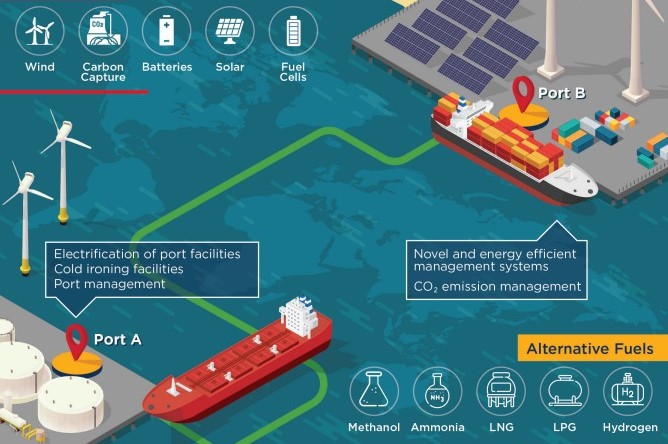ABS published the report “Green Shipping Corridors -Leveraging Synergies”, analyzing green corridors and how they can contribute to the landscape of maritime decarbonization.
What is a green corridor?
According to the report, in the context of green corridors, this specifically indicates the geographical connection between two locations and the enabling environment that helps reduce emissions. A corridor, apart from being a geographical reality, can also serve as an enabling environment for new business cases and policies which help organizations achieve low or zero-carbon emissions.
A corridor should be bottom up, created based on a detailed pre-feasibility and feasibility assessment that clearly answers the following:
- What is the business case?
- What are the alternative fuels available and infrastructure present and ease of development of new infrastructure?
- What are the policies and governmental support that help enable the development of a green corridor?
What are the foundational elements?
#1 Collaboration across the value chain: Commitment across the value chain is an integral aspect of any green corridor since fundamentally, a green corridor is a value chain decarbonization initiative bringing together stakeholder groups that are solving the same problem.
For a green corridor to succeed, each of the members of the value chain need to collaborate, particularly at the intersection of their operational boundaries. This interaction will improve interoperability and may initially lead to boundaries blurring, but over a period, the entire corridor will operate as a system, that not only helps in maritime decarbonization, but also leads to economic opportunity that was not previously envisioned.
The collaboration should be built on a foundation of open dialogue among the stakeholders in a trusting environment with well-defined contracts to prevent any issues at the interface between the stakeholders.
#2 Development of alternative fuel pathways and port infrastructure: An important decision-making criterion for a green corridor will be quantifying the energy demand for the corridor based on the evolution of the route, vessel utilization, vessel engine type and size.
Additionally, the fuel producers in the consortium of project developers will need to calculate the alternative fuel demand based on the fuel characteristics.
Decarbonization is economy wide and hence, the shipping industry will need to assess the availability of these fuels for the shipping industry.
The green corridor consortium should help fuel producers by guaranteeing long-term demand to allow for capacity development and to corner the supply.
This could be the most critical part of the development of the corridor, since fuel supply is at the underlying foundation of a green corridor.
#3 Shipping impact/logistical case for a green corridor: Having a solid business case transforms a green corridor from a theoretically possible action into a commercially practical solution.
The business case may vary from corridor to corridor, but inevitably the driver will be demand for emission reduction from the value chain coupled with an optimal solution from an economic standpoint.
The various solutions for implementation such as methanol, LNG, ammonia or hydrogen, all have varying levels of commercial viability that are regionally dependent.
Therefore, the fuel selection process will need to include a lifecycle cost analysis for the various solutions. This process will detail the emission reduction impacts of each solution, the CAPEX associated with implementation, and the OPEX associated with continuous operations.
Consideration also can be made to lower prices of alternative fuels over time as supply scales.
#4 Policy and regulations: Policy and regulations are a catalyst for enabling these large initiatives that cover multiple stakeholders across different sectors of the economy.
While the green shipping corridor at the outset seems like a marine-focused initiative, it has the potential to impact multiple sectors of the economy and hence, a top-down regulatory and policy environment that is supportive is imperative.
Economic policies that help with financial barriers and regulatory policies that reduce non-financial barriers in combination are strong catalysts for solutions that are on the verge of commercial viability.
Current green corridors
- First green hydrogen corridor between north and south of Europe: Cepsa and the Port of Rotterdam will work together to establish the first green hydrogen corridor between southern and northern Europe, ensuring a green hydrogen supply chain between two of Europe’s main ports, Rotterdam and Algeciras, as agreed in the Memorandum of Understanding (MoU) signed by both parties.
- Green corridor between Stockholm-Turku: RMC, Viking Line, Åbo Akademi and Kempower are developing a carbon-neutral sea route between Stockholm and Turku. Business Finland has granted the project significant funding.
- World’s longest green and digital corridor: The Maritime and Port Authority of Singapore and the Port of Rotterdam Authority have signed a memorandum of understanding (MoU) to establish the world’s longest Green and Digital Corridor to enable low and zero carbon shipping.
- Green corridor between ports of Halifax and Hamburg: The Halifax Port Authority and Hamburg Port Authority agreed to work to decarbonise the shipping corridor between the two ports.
Industry’s efforts on establishing Green Corridors
Analyzing more green corridors, the Mærsk Mc-Kinney Møller Center for Zero Carbon Shipping, in a joint effort with McKinsey & Company, has developed a new blueprint for assessing the feasibility of green corridors.
The blueprint provides an approach to designing and demonstrating the feasibility of green corridors. It is intended to serve as a ready-to-use guide for any stakeholder involved in green corridors for decarbonizing shipping.
In addition, green corridors are also of special interest to the Arctic. For this reason, the Clean Arctic Alliance has written to the ministers from Norway, Denmark, Iceland, Greenland and the Faroe Islands to propose a number of domestic and international actions which would help to rapidly kick-start the establishment of these green corridors in Arctic waters.
According to the Alliance, within the 12 nautical territorial limit of each country’s domestic waters, its suggests the banning of the use and carriage of polluting heavy fuel oil (HFO). Norway has already introduced such a ban in the waters around Svalbard.
Such a ban will be an international requirement from July 2024 in some Arctic waters, when the International Maritime Organization’s (IMO) Arctic HFO ban comes into effect.
Finally, the Global Maritime Forum also published a paper considering emerging approaches to defining, initiating, and governing Maritime Green Corridors, and puts forward recommendations in each area.
Building on the initial conceptualization put forward in The Next Wave and the signatories of the Clydebank Declaration, as well as responding to multiple requests from industry and governments taking an interest in the concept, the paper aims to reinforce the most effective and impactful approaches while acknowledging the need for flexibility.






























































